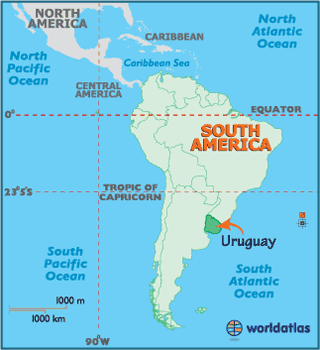Unit 6: Lesson 4
Unit 6: Lesson 4

Overview
Hola!
Como estas?
In this last Unit Lesson, we will explore some Hispanic-speaking cultures through one of the 21 Spanish-speaking countries. For this lesson, you will need speakers or headphones.
Let’s begin! Vamos a comenzar!
Geography
Uruguay, on the east coast of South America, south of Brazil, and east of Argentina, is comparable in size to Oklahoma. The country has a low, rolling plain in the south and a low plateau in the north. It has a 120-mile (193 km) Atlantic shoreline, a 235-mile (378 km) frontage on the Rio de la Plata, and 270 mi (435 km) on the Uruguay River, its western boundary.
History
Before European settlement, Uruguay was inhabited by indigenous people, the Charrúas. Juan Díaz de Solis, a Spaniard, visited Uruguay in 1516, but the Portuguese were first to settle it when they founded the town of Colonia del Sacramento in 1680. After a long struggle, Spain wrested the country from Portugal in 1778, by which time almost all of the indigenous people had been exterminated. Uruguay revolted against Spain in 1811, only to be conquered 1817 by the Portuguese from Brazil. Independence was reasserted with Argentine help in 1825, and the republic was set up in 1828.
Interesting Facts
Uruguay Legalizes Same-Sex Marriage On April 10, 2013, lawmakers in Uruguay voted to legalize same-sex marriage, making Uruguay the 12th country in the world to do so. The new law made Uruguay the second country in Latin America to pass legislation in support of gay marriage. Uruguay's neighbor, Argentina, legalized same-sex marriage in 2010. President Mujica and his coalition of political parties, Broad Front, backed the law. Mujica was expected to sign the new legislation within ten days. Uruguay's marriage equality bill first passed through the Senate with a vote of 23- 8. Then, it passed in the lower house by a vote of 71-21. The legislation was another step toward same-sex equality in the country. In 2009, Uruguay became the first Latin American country to allow adoption for same-sex couples. It was also the first country in Latin America to have civil union legislation for same-sex couples. That national civil union law was passed in 2008.


Details
Population: 3,316,328
Primary Language: Spanish
Currency: Peso Uruguayo
Capital City: Montevideo
Videos (Click Image to View Video)
